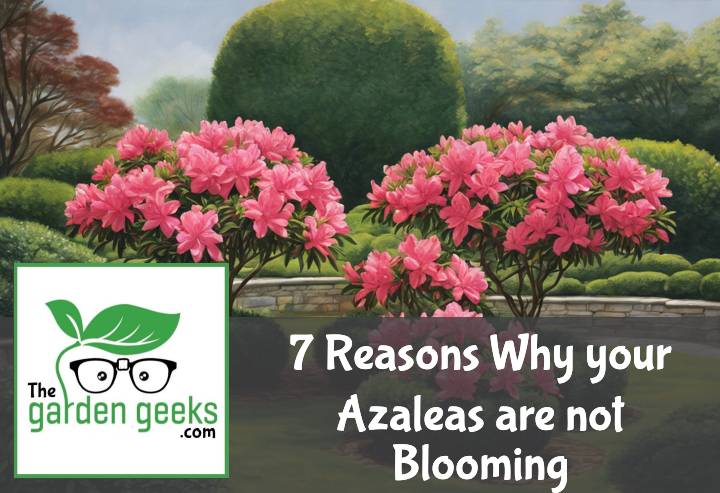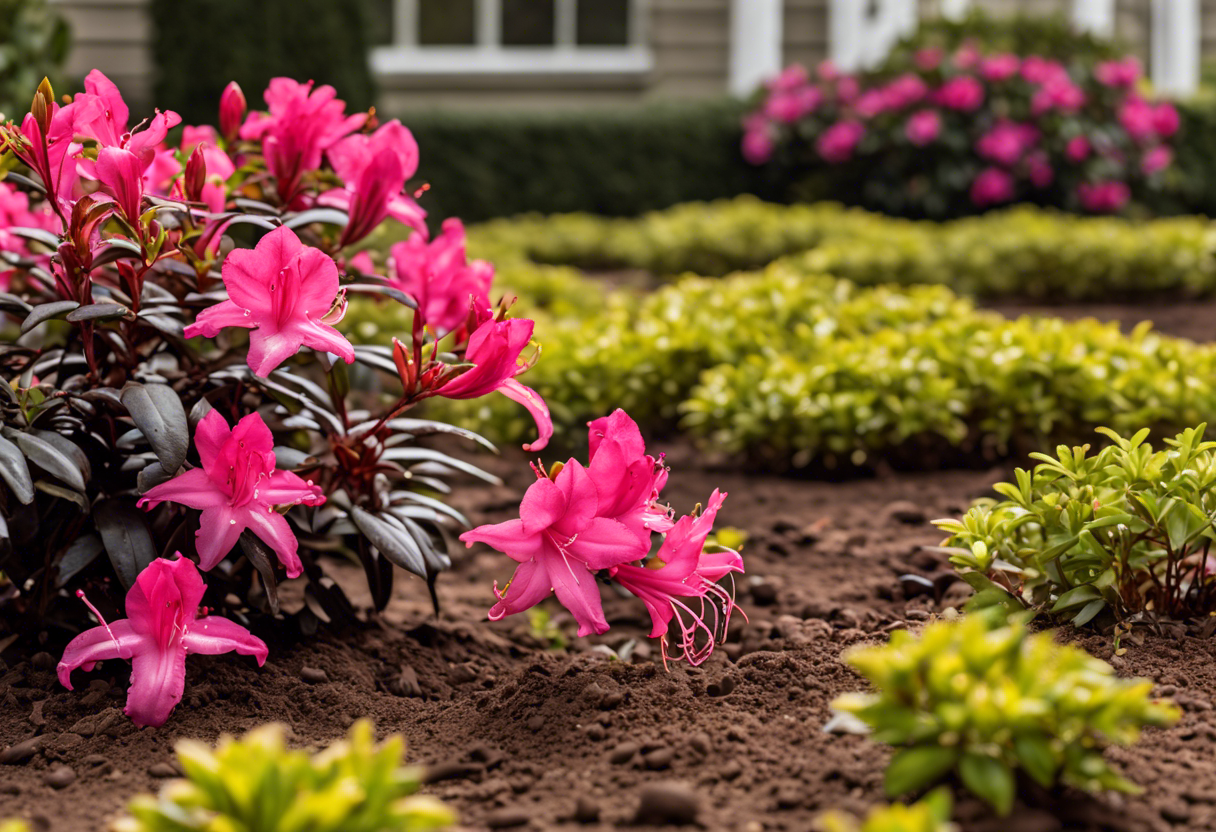Ever wondered why your backyard’s pride, the vibrant Azaleas, are just not blooming? Well, you’re not alone. I’ve been there too, scratching my head as I stared at the stubborn buds. There could be several Reasons Why your Azaleas are not Blooming.
From inadequate sunlight to incorrect watering practices or even unsuitable climate conditions – it’s like solving a jigsaw puzzle! But don’t worry, we’ll crack this code together. So grab a cup of coffee and keep reading about the 7 reasons why your Azaleas are not blooming.
Key Takeaways
- Azaleas may not bloom due to incorrect planting, like too deep or in poor soil.
- Inadequate sunlight can hinder blooming; Azaleas need 4-6 hours of indirect light daily.
- Over-fertilization can lead to lush foliage at the expense of blooms.
- Pruning at the wrong time, especially late in the season, can remove next year’s buds.
- Pests and diseases like lace bugs or petal blight can affect blooming.
- Improper watering, either too much or too little, can cause issues.
- Extreme weather conditions such as frost or heat waves can damage buds.
Inadequate Sunlight
One of the main Reasons Why your Azaleas are not Blooming could be that they’re not getting enough rays. You see, these beauties have specific Azaleas sunlight needs. If they don’t get their daily dose of Vitamin D, it can lead to insufficient sunlight effects, messing up their blooming schedule.
Understanding Azaleas’ Sunlight Requirements
Azaleas aren’t divas, but they do have some specific light requirements. The optimal amount of sunlight for these plants is about four to six hours a day. Too little or too much can impact their growth and flowering.
The intensity of sun for azalea bloom also matters. They prefer morning sun and afternoon shade – a bit like my Aunt Martha, who loves her morning tea in the garden but retreats indoors when the afternoon heat kicks in.
Signs of Insufficient Sunlight Exposure
If your azalea plant is acting more like a wallflower than a showstopper, it might be due to insufficient sun exposure. Signs of low light in azaleas include leggy growth and fewer flowers.
Another telltale sign is if your plant’s leaves start turning yellow – not exactly the vibrant display you were hoping for! These symptoms all point towards azalea blooming issues due to less light. So make sure your green buddies get their fair share of sunshine!
Incorrect Watering Practices
One of the main Reasons Why your Azaleas are not Blooming could be incorrect watering practices. Proper azalea care involves understanding how much water these plants need and recognizing the signs of overwatering or underwatering.
How Much Water Do Azaleas Need?
Azaleas aren’t too fussy, but they do have specific watering needs. Depending on factors like climate and soil type, the best water amount for azaleas can vary. In general, azaleas prefer moist, well-drained soil.
They don’t appreciate being drowned or left high and dry. If you’re wondering how often to water azaleas, a good rule of thumb is to keep the soil consistently moist but never soggy.
Remember, when it comes to watering azaleas in different climates, more isn’t always better. In cooler climates, your azaleas might need less water than their sun-basking cousins in warmer regions.
Overwatering and Underwatering Symptoms
Now let’s talk about what happens when you give your azalea too much love (or not enough). Overwatered azalea symptoms can include yellow leaves and root rot – not exactly the picture of plant health!
On the other hand, underwatered azalea signs might show up as wilting leaves and stunted growth. Both conditions can seriously affect blooming.
So if you’re noticing any of these symptoms, it’s time to reassess your watering habits! Remember that correct watering is key to keeping your azalea happy and blooming beautifully.
Poor Soil Conditions
One of the Reasons Why your Azaleas are not Blooming could be poor soil conditions. Azaleas are pretty picky about their dirt, and if the soil doesn’t meet their requirements, they might just refuse to bloom.
Ideal Soil Type for Azaleas
Azaleas love well-drained, humus-rich soils. They’re like the Goldilocks of plants – the soil can’t be too sandy or too clayey; it has to be just right. This best soil for azaleas allows them to absorb nutrients effectively, promoting healthy growth and a spectacular bloom.
But wait, there’s more! These plants also need a good amount of organic matter in their soil. It’s like adding a little extra spice to their favorite dish. This azalea-friendly soil condition helps retain moisture and nutrients, creating an ideal environment for those beautiful blooms.
Impact of Soil pH on Azalea Blooming
Now let’s talk about pH levels. If you remember your high school chemistry (don’t worry, no pop quiz here), you’ll know that pH measures how acidic or alkaline something is. Well, azaleas prefer their soil slightly on the acidic side.
The optimal pH for azaleas is between 4.5 and 6.0. When the pH level is within this range, it allows azaleas to absorb essential nutrients from the soil effectively, leading to healthier plants and more vibrant blooms.
However, if your garden’s pH is off balance (too high or too low), it can hinder nutrient absorption and lead to poor blooming or even plant stress. So keep an eye on that pH level folks! Remember: happy soil equals happy azaleas!
Lack of Proper Pruning
Pruning your azaleas is a bit like giving them a haircut. Do it right, and they’ll look fabulous. Mess it up, and well… let’s just say the results can be less than blooming marvelous. Azalea pruning techniques play a crucial role in promoting azalea blooms, but timing is everything.
When to Prune Azaleas
The best season for pruning azaleas? Right after they’ve finished blooming. This gives them plenty of time to recover before their next azalea bloom cycle kicks in. If you’re wondering when to trim azaleas, think late spring or early summer. The impact of pruning on bloom time can be significant, so don’t miss your window!
Effects of Improper Pruning on Blooming
Now, what happens if you get the timing wrong or go a little snip-happy with your shears? Well, the consequences of bad pruning can be pretty dire for your azaleas’ flower production. Prune at the wrong time, and you might just find yourself asking “why are my azaleas not blooming?” So remember folks, improper trimming and flower production are two things that definitely don’t mix!
Pests and Diseases
Pests and diseases can be a real party pooper for your azaleas. They’re like uninvited guests who crash the party and ruin the fun, in this case, the blooming of your azaleas.
5.1 Common Pests Affecting Azaleas
Let’s talk about some common Azalea pests that could be preventing your plants from blooming. First off, we have lace bugs. These tiny critters suck the life out of azalea leaves, leaving them looking bleached or stippled.
Now, onto another culprit – Azalea caterpillars. These guys are not as cute as they sound! They can defoliate an entire plant if left unchecked. So, keep an eye out for these common garden pests.
And don’t get me started on spider mites! These microscopic menaces cause yellowing and bronzing of leaves which can seriously hamper blooming. Remember folks, good pest control for azaleas is crucial to prevent such insect damage in azaleas.
5.2 Diseases that Hinder Azalea Blooming
Moving on to diseases now – another major reason why your azaleas might not be putting on their best show. Let’s start with petal blight – it’s a fungal disease that causes flowers to turn brown and mushy.
Next up is leaf gall – it makes leaves swell up and look all weird and distorted. Not exactly conducive to healthy blooming, right? And then there’s root rot, a nasty condition caused by overwatering or poor drainage that can lead to wilting and death of the plant.
These are just some of the diseases in azaleas that could be hindering bloom growth. It’s important to understand these plant disease effects and take necessary measures for disease control for azaleas.
Remember, a healthy plant is a happy plant! So, keep an eye out for these health issues in azaleas and your plants will thank you with a spectacular bloom.
6. Unsuitable Climate Conditions
One of the Reasons Why your Azaleas are not Blooming could be unsuitable climate conditions. Azaleas have specific azalea climate requirements and any deviation from these can affect their blooming.
6.1 Optimal Climate for Azalea Growth
Azaleas thrive in climates that offer moderate temperatures, high humidity, and plenty of sunlight. The ideal temperature for azaleas is between 60-75°F (15-24°C).
They also appreciate a good dose of humidity to keep their leaves lush and vibrant. As for sunlight, while they can tolerate partial shade, they do best with at least four hours of direct sunlight each day. These optimal growing conditions for azaleas contribute significantly to their successful blooming.
6.2 Adverse Weather Effects on Blooming
On the flip side, adverse weather conditions can negatively impact azalea blooming. For instance, frost can cause significant frost damage in azaleas, leading to bud death and consequently no blooms.
Similarly, drought stress can lead to wilting and reduced flowering as the plant tries to conserve water. On the other hand, excessive rain can lead to root rot which ultimately affects the overall health of the plant including its ability to bloom.
7 . Nutrient Deficiency
Another potential reason why your azaleas are not blooming could be nutrient deficiency. Just like humans need a balanced diet, plants too have specific azalea nutrient needs that must be met for them to thrive and bloom successfully.
:7 .1 Essential Nutrients for Azalea Health and Bloom
Key nutrients essential for healthy growth and blooming in azaleas include nitrogen, phosphorus, and potassium. Nitrogen promotes leafy growth but it’s phosphorus that plays a crucial role in bloom production.
A phosphorus role in plant bloom is to encourage the development of flowers, fruits, and seeds. Potassium, on the other hand, helps with overall plant health and resistance to diseases.
:7 .2 Identifying Nutrient Deficiencies in Azaleas
Recognizing signs of nutrient deficiencies in azaleas can help you address the problem before it affects blooming. Yellow leaves could indicate a nitrogen deficiency in azaleas, while stunted growth might suggest a lack of phosphorus.
Poor blooming could be a sign of potassium deficiency or it could also indicate an overall nutrient deficiency. By recognizing these signs early, you can take steps to correct the deficiencies and hopefully get your azaleas back on track to producing those beautiful blooms we all love!
To Wrap Up
In the grand scheme of things, your Azaleas are just like us – they need the right conditions to shine. If they’re not blooming, it’s their way of saying “Hey, something’s off here!”. So remember the Reasons Why your Azaleas are not Blooming we’ve discussed and make those changes.
And hey, don’t forget to pat yourself on the back for being a plant parent who cares. Keep learning, keep growing (pun intended), and soon you’ll have azaleas that are the envy of the neighborhood!





